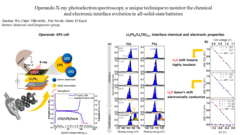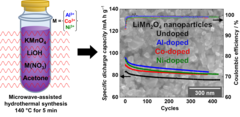Recherche
Publications 2015
Electrochemistry Laboratory (LEC)
Operando X-ray photoelectron spectroscopy, to monitor the chemical and electronic interface evolution in all-solid-state batteries
Degradation of the solid-electrolyte interface occurring during cycling is currently one of the most challenging issues for the development of all-solid-state batteries. Here we designed a unique electrochemical custom made cell for operando X-ray photoelectron spectroscopy (XPS) capable of maintaining high mechanical pressure with reliable electrochemistry and able to monitor in real-time the surface (electro-)chemical reactivity at the interfaces between the different composite.
Post mortem/operando XPEEM: for studying the surface of single particle in Li-ion battery electrodes
X-ray photoemission electron microscopy (XPEEM) with its excellent spatial resolution is a well-suited technique to elucidate the complex electrode-electrolyte interface reactions in Li-ion batteries. It provides element-specific contrast images and enables the acquisition of local X-ray absorption spectra on single particles. Here we demonstrate the strength of post mortem measurements and we show the first electrochemical cell dedicated for operando experiments in all-solid-state batteries.
Excellent cycling stability of graphite in all-solid-state battery using sulfide solid electrolyte
All-solid-state lithium ion batteries represent a promising battery technology for boosting the volumetric energy density and promising a superior safety. In this study excellent cycling stability of graphite anode material have been demonstrated in combination with sulfide-based solid electrolyte. Furthermore we evaluated the stability of the graphite-electrolyte interface by analyzing the normalized cumulative irreversible charge during cycling experiments.
Open Positions
Investigation of the electrochemical performance and the surface layer formation of cycled thin films of amorphous Si in carbonate and ionic liquid based electrolytes
High performance doped Li-rich Li1+xMn2-xO4 cathodes nanoparticles synthesized by facile, fast and efficient microwave-assisted hydrothermal route
Li-rich nanoparticles of Li1+xMn2-xO4 doped with Al, Co or Ni are successfully synthesized using a facile, fast and efficient microwave-assisted hydrothermal route. In this study, we demonstrate that nanocrystallinity and cationic doping play an important role in improving the electrochemical performance with respect to LiMn2O4 microparticles. They significantly reduce the charge-transfer resistance, lower the 1st cycle irreversible capacity to 6%, and achieve a capacity retention between 85 and 90% after 380 cycles, with excellent columbic efficiency close to 99%.
Publications 2018
Electrochemistry Laboratory (LEC)
LEC Events/Seminars
Die Seminare finden im Raum ODRA/111 jeweils am Mittwoch um 11:00 Uhr statt. Externe Gäste (ausserhalb des PSI) sind willkommen, werden aber gebeten, sich im Labor-Sekretariat bei Frau Cordelia Gloor unter Tel.: +41 56 310 2919 oder per e-mail anzumelden. Lectures take place in room ODRA/111 on every Wednesday at 11:00 am. External guests (from outside PSI) are welcome, but are requested to register with our secretary Cordelia Gloor at phone: +41 56 310 2919 or via e-mail.
LEC Publications
Some selected Review Articles, Book Chapters, or Books from the Laboratory For a complete list of publications see PUBLICATIONS ANNUAL.




